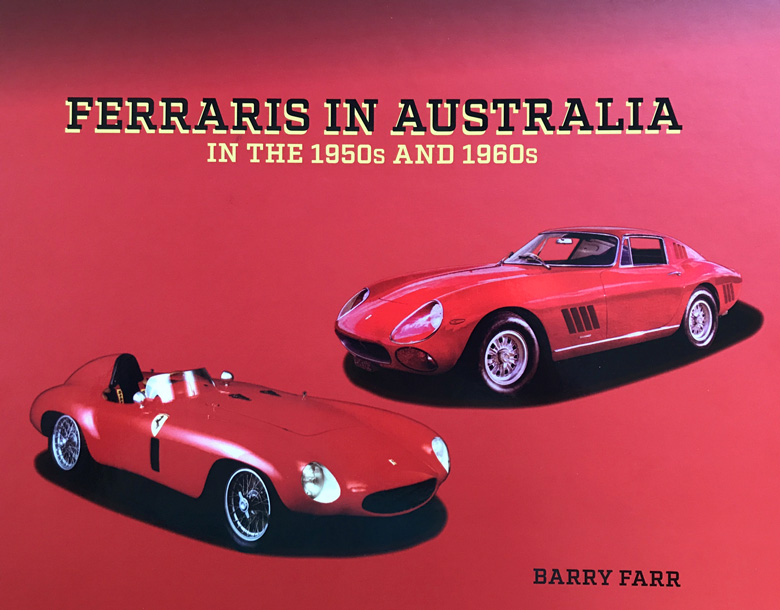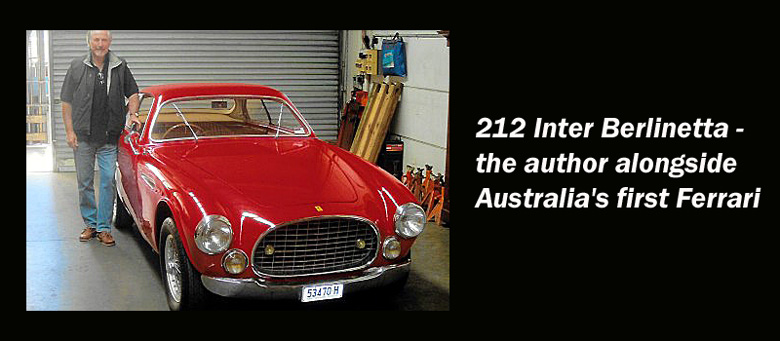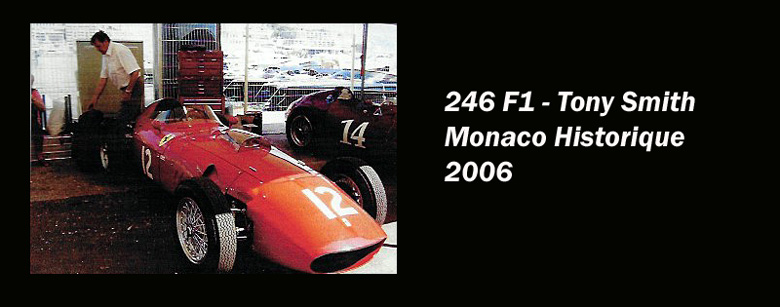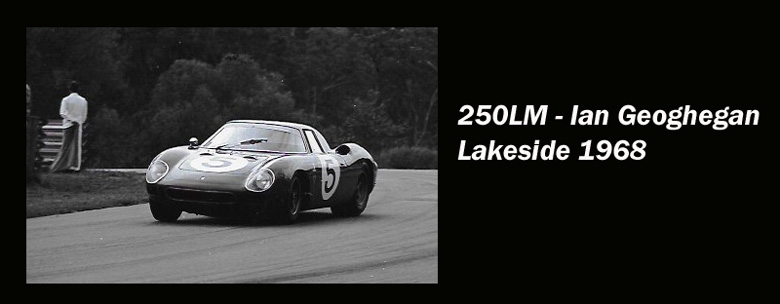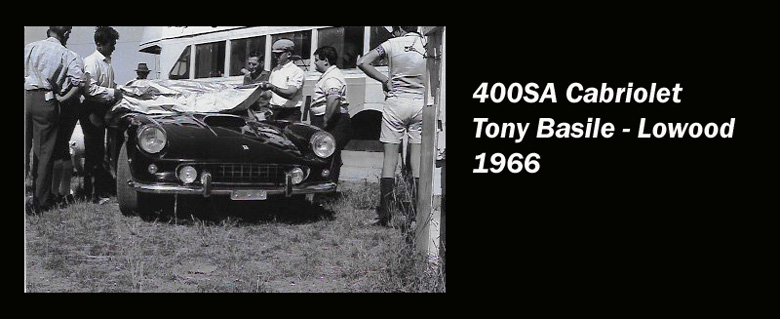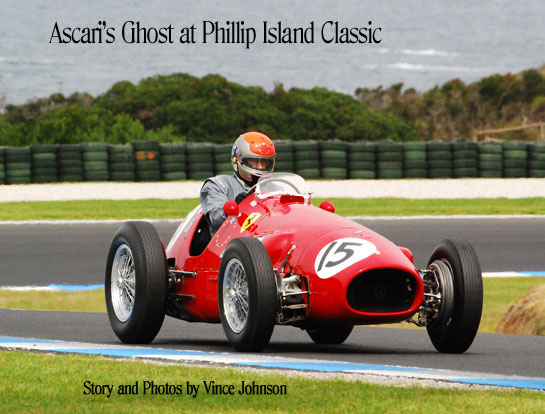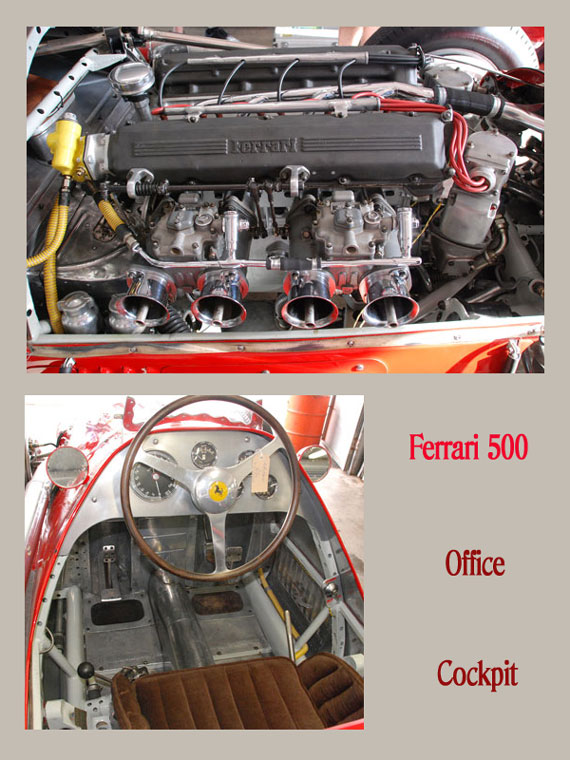In this article author Barry Farr describes the background to his book “Ferraris in Australia in the 1950s and 1960s” which is a comprehensive written and pictorial history of all the Ferraris that entered the land down under during the 1950s and 1960s. [Ed.]
By Barry Farr
Whilst the likes of Jose Froilan Gonzales and Luigi Chinetti helped establish the Ferrari marque internationally, Ferrari’s presence in Australia was fostered by Englishman Peter Whitehead, Melbournian Bill Lowe and Sydney-sider David McKay. The common factor among these three gentlemen was that each was an esteemed racer in his own field – Whitehead in F1, Lowe in hill climbs and McKay in touring and sports cars. As well, McKay was a respected motoring journalist and thus spread the word about his Ferrari exploits.
Up until the 1950s, motor racing in Australia comprised of mainly locally devised Specials. This changed in 1954, when New Zealand initiated international races which culminated in the late 60s with the Tasman Series. In between, a special racing program was introduced at Albert Park, Melbourne in support of the Olympics in 1956, and long-distance sports car races were held at Surfers Paradise in the years 1966-68. All of these events attracted international drivers of note, many of whom were provided with Ferrari works cars. As more and more Australians became aware of and were fascinated by these beautifully crafted formula and sports cars and the sound they emitted, Australians began purchasing Ferrari road cars.
The first, a 212 Inter berlinetta ordered by Bill ‘Pappy’ Lowe in Melbourne arrived in 1952 and still remains in Oz to this day. Lowe became the first Ferrari agent outside of Europe and remained the Australian Ferrari distributor until 1970, by which time he had imported a range of Ferraris including the following: 250GT Pinin Farina, 250GT 2+2 (GTE), 250GT SWB, 330GT 2+2, 275GTB, 330GTC, 365GT 2+2, 365GTC and 365GTB/4 (Daytona), all of which are detailed in the book.
The first formula race car to enter Australia was a 125F1 which Peter Whitehead brought in for the 1954 Australasian summer series of races. This was an ex-works 2-stage supercharged long wheelbase GP car which in later years Tom Wheatcroft purchased as the foundation vehicle for his Donington Collection.
Given Whitehead was the first privateer to whom Enzo Ferrari sold a GP car, he convinced Ferrari to provide two 625F1s for himself and Tony Gaze for the 1955 Australasian summer series which incorporated the South Pacific Road Racing Championship, which Whitehead won. Tom’s son Kevin brought the ex-Gaze 625F1 back to Australia in 2012 where Rick Hall raced it at Phillip Island. (See Sidebar below)
The Olympics held in Melbourne in December 1956 prompted Peter Whitehead, Reg Parnell and Ken Wharton to enter four Ferraris in the Australian Grand Prix and supporting sports car races a week before the Olympics. Whitehead finished 3rd in the AGP and won a support cup race in his ex-works (Paul Frere, Giuseppe Farina) 555 Super Squalo whilst Parnell came 6th in the AGP and 4th in the support cup race in the sister ex-works (Maurice Trintignant, Pietro Taruffi, Paul Frere) 555 Super Squalo.
For the supporting sports car races Whitehead entered the ex-works (Olivier Gendebien, Phil Hill, Alfonso de Portago, John Kimberly) 857S Monza and Ken Wharton finished 3rd in the 750 Monza that Luigi Pioti and Gin Luigi Zanini had entered in the 1955 Mille Miglia. Unfortunately, in January 1957, Wharton crashed and died in the Monza in a New Zealand sports car race. The restored car now resides in the Southward Car Museum in Wellington.
Another 750 Monza, the car that was raced in the 1955 Le Mans by Mike Sparken and Masten Gregory, was purchased by Australian Stan Coffey who also entered the two weeks of racing events at Albert Park in support of the Olympics. In subsequent years, Andrea Burani entered it in the 2005 Mille Miglia Retrospective, it became part of the Brandon Wang Collection and made its way onto the track again at Laguna Seca in 2015.
Also in 1956 Australia’s Italian Consul imported a 212 Export in which Count Gerino Gerini and Luciano Donazzolo had entered the 1953 Mille Miglia. In Australia this car saw some track work and when owned by another Australian Andy Brown, was entered in the 1984 Mille Miglia Retrospective with Andy’s son David.
Another famous Ferrari that made its way to these shores was the ex-works (Oliver Gendebien, Masten Gregory, Wolfgang von Trips) 250TR Prototype #0666TR which debuted in the 1957 Nurburgring 1000. Many will be aware that when running in the 1958 Le Mans 24 Hours with NART livery, Dan Gurney’s co-driver Bruce Kessler, collided with another competitor in the dark and rain resulting in it catching fire only to be extinguished by spectators with sand and soil. After a new Scaglietti body was fitted, Rod Carveth purchased the car and entered the Sebring 12 Hours, the Nurburgring 1000 and the Le Mans 24 Hours but luck was not with him. Thereafter, he brought the car to Australia and raced it at Bathurst and Lowood. The text relating to this car is quite voluminous, suffice to say it passed through a number of owners including John Shirley, who owned it for almost a decade.
Another interesting story relates to the ex-works 246 F1 in which Phil Hill won the Italian GP at Monza in 1960. At the close of the 1960 F1 season Ferrari destroyed most of the team’s 246 F1s but one surviving example was sold to New Zealander Pat Hoare. As an NZ Army Officer Hoare had helped liberate Maranello during WWII and so became a personal friend of Enzo. After racing the car in both the 1961 and 1962 Australian Gold Star series, Hoare put a sports car body on it and offered Jackie Stewart a test drive. When Neil Corner purchased the car, he refitted the F1 body and it was raced by his son Nigel, then extensively by Tony Smith.
David McKay ordered a 250LM three different times. He cancelled his first order because of delays in homologation but not before the car was on its way to Australia. Bill Lowe took receipt and used it as his personal transport before sending it back to the factory where a Drogo long nose was fitted. Purchased by Maranello Concessionaires UK, it was raced principally by Mike Parkes and Richard Atwood. McKay’s second order was cancelled in time, still awaiting homologation. The third order resulted in McKay taking delivery of what would eventually become Australia’s most recognized and loved Ferrari, as it was a winner almost every time it raced in Australia, NZ and Laguna Seca, principally driven by Spencer Martin. The story of this car is the most extensive in the book and fittingly, enthusiasts worldwide are occasionally privileged to see this car as current owner Ralph Lauren ships it to various locations for display.
In the latter half of the 1960s, two motor racing series attracted some very special Ferraris to Australia. For the inaugural Surfers Paradise 12 Hours for sports cars in 1966, Jackie Epstein entered his ex-Viscount Edward Portman/Roy Salvadori 250LM with Aussie Paul Hawkins as co-driver and David Piper entered his ex-Mike Parkes/Jean Guichet 1965 Monza 1000 winner, 365 P2 with co-driver Richard Attwood.
In 1968 Ferrari provided a 246T for Chris Amon to compete in the Tasman Series but it was no match against Jim Clark in the Lotus 49T. Interestingly though Graham Adelman brought the car back to Australia in 2008 for the Tasman Revival meeting at Sydney’s Eastern Creek International Raceway where, with Rob Hall driving, it won the Repco Tasman Cup from a 36 car field.
Knowing Chris Amon was to race the 246T in the 1968 Tasman Series, David McKay arranged for the ex-factory (Mike Parkes, Ludovico Scarfiotti, Paul Hawkins, Johnathan Williams) 330 P4 to be brought to Australia for Amon to drive in the sports car races supporting the Australian half of the Tasman series. This car finished 2nd in the famous 1-2-3 finish of the 1967 Daytona 24 Hours and 2nd in the that year’s Le Mans 24 Hours. In 2004 this car was seized by the IRS for unpaid taxes after Walter Medlin’s Ferrari car barn was exposed after being blown away by Hurricane Charley.
For the 1969 Tasman Series, Ferrari provided two more powerful 246 Ts for Chris Amon and Derek Bell, the former this time winning the Tasman Championship. New Zealander Graeme Lawrence purchased the car and proceeded to win the 1970 Tasman Formula series as well as the Singapore and Selangor GPs, after which the car ended up in Pierre Bardinon’s French Mas du Clos private collection followed by the Violati Collection at Museo Maranello Rosso in Italy.
The foregoing briefly touches on just 20 of the 65 Ferraris extensively covered in the book which is the culmination of 5 years comprehensive research by the author. The book itself is a large, limited edition, hard cover, landscape (15”x12”) of 176 pages on high grade art paper with 530 colour and black and white images. Each of the 299 limited edition books is specifically numbered and costs AUD175 plus p&p. Enquiries can be directed to barry.farr09@gmail.com.
Sidebar: 2012 Phillip Island by Vince Johnson
It has been sixty years since Alberto Ascari won not only his first Formula 1 World Championship, but Ferrari’s as well. It was fitting that the car which gave him nine straight victories during 1952-53 should fire up in Australia a week before the start of the 2012 F1 season. This was not the first time this car had run down under.
After earning Ascari his second championship, chassis number 5 (0480) was sold to Australia’s first F1 driver, ex-WW2 Spitfire Squadron Leader Tony Gaze. Gaze’s debut in the 1952 Belgian Grand Prix at Spa on 22 June had also been the first outing for this very car. The factory fitted it with a new 3-liter 750 Monza engine for Gaze and it won races in South Africa and New Zealand. In 1956 Gaze sold it to Australian Lex Davison. The Ferrari continued its winning ways with six major victories, including consecutive Australian Grand Prix successes in 1957-58 before leaving Australia in the 60’s. Its return after five decades created a hive of interest in the pits and on the track at this year’s Phillip Island Classic.
After UK restoration specialists Hall & Hall returned the car to its correct 2-liter F2 specifications for owner Kevin Wheatcroft, it was air freighted from its home at the Donington Collection in England to the southern hemisphere’s largest historic race meeting. Rick Hall accompanied the car, driving it in the Regularity events and special parades.
